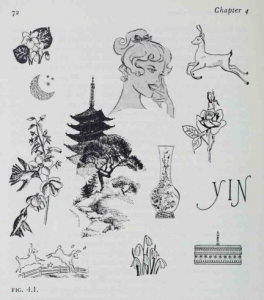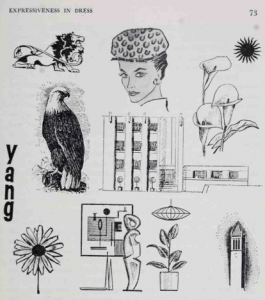 Belle Northrup’s work was continued by Harriet Tilden McJimsey in her book Art in Clothing Selection, first published in 1963 and then updated and retitled Art and Fashion in Clothing Selection ten years later. You can electronically borrow the updated version at Open Library. This is the book that I am going to be talking about today.
Belle Northrup’s work was continued by Harriet Tilden McJimsey in her book Art in Clothing Selection, first published in 1963 and then updated and retitled Art and Fashion in Clothing Selection ten years later. You can electronically borrow the updated version at Open Library. This is the book that I am going to be talking about today.
This book was actually intended to be used as a college home economics textbook. The things I am going to be talking about today are only one chapter of the book. The rest of the book goes into the history of clothing, social psychology, apparel design, and lots of other subjects. An interesting side note: Carol Tuttle was a home economics major in the 1970s, so it’s feasible that she read this book for her coursework.
In the chapter on yin/yang and types, McJimsey takes Northrup’s work on yin/yang and animal archetypes and introduces the Dramatic, Natural, Classic, Gamine, Romantic and Ingenue types that we all know and love. (If someone came up with these types before McJimsey, please let me know in the comments.) She says that Dramatic and Natural are the yang types, Classic and Romantic are mixed (Romantic being mixed sounds strange to those of us who are coming from Kibbe), and Gamine and Ingenue are yin. Her yin/yang classifications seem almost to be based on age more than anything else. Gamine and Ingenue are for the most part limited to teens and those in their early 20s, Romantic is more sophisticated and probably wouldn’t be your type until after 25, Dramatic and Natural always look older than they are, and so on. Even though gamine is boyish, since it’s so youthful, it’s still yin.
 In contrast to people like David Kibbe and Carol Tuttle who are adamant that people fit into one category and one category alone (or one category and on secondary in Tuttle’s case), McJimsey’s approach is closer to that of John Kitchener, who types people by percentages of essences, rather than fitting people into one individual type. McJimsey says that there are very few “pure” individuals who will fit entirely into Gamine or Ingenue or Natural. Almost everyone will pull their “style essence,” as she puts it, from several types.
In contrast to people like David Kibbe and Carol Tuttle who are adamant that people fit into one category and one category alone (or one category and on secondary in Tuttle’s case), McJimsey’s approach is closer to that of John Kitchener, who types people by percentages of essences, rather than fitting people into one individual type. McJimsey says that there are very few “pure” individuals who will fit entirely into Gamine or Ingenue or Natural. Almost everyone will pull their “style essence,” as she puts it, from several types.
Next post, I’ll begin looking at McJimsey’s types, starting with Dramatic.
I’ve posted the charts from McJimsey in the gallery below. More illustrations can be found on my Research Pinterest board.
Sorry, nothing found.
MKsojourn
October 19, 2015 at 12:47 pmIt looks like Kibbe may have based his system somewhat on McJimsey’s. I just used the “Personality Analysis” chart above and wrote my answers on paper, as if I were taking the Kibbe test. From my prior posts, you know that I was suspecting Soft Natural as my Kibbe type, and the McJimsey system seems to confirm this. My primary type under McJimsey would be Natural, but my undercurrent is more Gamine than Romantic. Interesting! My answers were:
N – 7
G – 5
C – 4
R – 3
D – 2
McJimsey has a Natural Gamine category, if I remember correctly. I may explore this further. I do remember though that Kibbe says not to combine these types.
stylesyntax
October 19, 2015 at 3:37 pmMcJimsey doesn’t have a “Natural Gamine” category per se. Gamine, in McJimsey, actually becomes Natural or Classic later in life.
Kibbe doesn’t say not to combine gamine and natural. But he doesn’t really say to combine anything. You’re your base type with a possible Dramatic or Romantic influence–i.e., yang or yin. But if you read the book carefully, you’ll see that to qualify for Flamboyant Gamine, you actually need N answers on the quiz. It is “broadly angular,” not just “angular.” 20 Types saying that “Natural Gamine” is “missing” from Kibbe’s system has caused a lot of misunderstanding.
The way McJimsey would work would be that you would be primarily Natural, and then if you had, say, some Dramatic influence in your face, you would wear things near your face that were Dramatic. This is most similar to how John Kitchener of PSC works today. He gives people percentages. I’m not a big fan of this approach personally, though. I think it’s better to work with your gestalt.
Melissa
February 25, 2023 at 4:03 pmCarol Tuttle has brilliantly made the foundational aspects of other works and systems accessible and easy to understand. I rejected her system at first but after studying other systems and past works more closely I realized her system makes sense without being cumbersome.
stylesyntax
March 26, 2023 at 10:54 pmI do find that it’s a good system for those who want a more cohesive image, although I do personally find it limiting.
Amy Unruh
March 29, 2023 at 3:42 pmI do love the Dressing Your Truth system. It changed my life in regards to both fashion and understanding that those things I thought were weaknesses are just part of who I am and are actually strengths, and I’m not the only one with these traits. She does have people focus on Primary first, then Primary and Secondary. But she does say that we are all blends of the four types. I do find that I have desired to look into other systems only because I did find it limiting as far as body shape. Some things recommended for the type 1 don’t look right on me. I did find out at first that it was because some of the items I had picked out that fit type 1 individuals were just too bold for me and the fabrics too crisp. As a secondary 2, I need softened fabrics, but not too soft. I’m an extremely rounded and voluptuous woman, though, so straight items recommended don’t work for me, so I use other systems to help me figure out which lines will work better on me. I like that the systems can compliment each other. Interestingly, after trying an Asian makeup typing system, I narrowed in on a natural essence, which actually made me realize that some of the styles I had thought wouldn’t work on me because of my Romantic body actually will work and so it actually shows that Type 1 Secondary 2 recommendations work perfectly for me. It just helped cement my support of DYT. I find that it’s a great system if you don’t want to go down a dozen rabbit holes and get even more confused than you were when you started. Not that it isn’t fun to go down those rabbit holes. As a Type 1, I see the world through the lense of fun. I just wish I’d known this when I was younger. I’d have gone a completely different way in college.